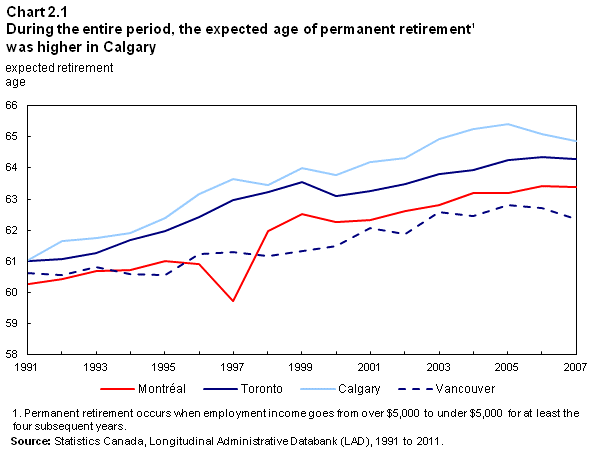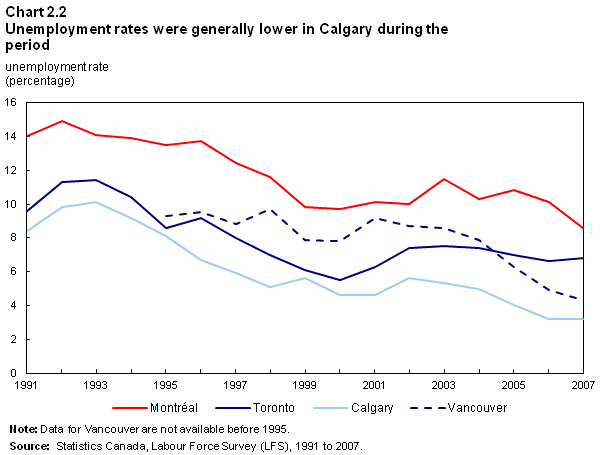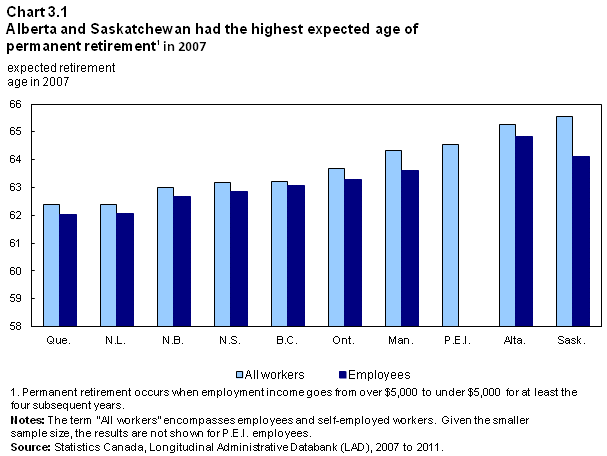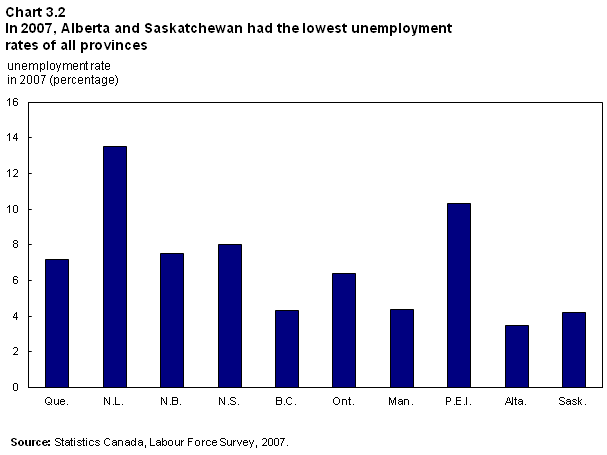The local unemployment rate and permanent retirement
Archived Content
Information identified as archived is provided for reference, research or recordkeeping purposes. It is not subject to the Government of Canada Web Standards and has not been altered or updated since it was archived. Please "contact us" to request a format other than those available.

by Diane Galarneau, Martin Turcotte, Yves Carrière and Eric Fecteau
[Release from The Daily] [Full article in PDF]
- Overview
- Introduction
- Lower unemployment rates are linked to higher expected retirement ages
- The expected retirement age is higher in the Prairies
- The impact of the local unemployment rate is confirmed
- Other factors influence retirement
- References
- Data sources, methods and definitions
- Notes
Start of text box
Overview
Using data from the Longitudinal Administrative Databank (LAD), this study examines whether the expected retirement age varies according to the unemployment rate of the economic region. In addition, the study verifies if the relationship between the unemployment rate of the economic region and the probability of permanent retirement remains when other factors are taken into account.
- In 2007, the expected retirement age in economic regions with lower unemployment rates was 64.2 years, compared with 62.7 years in economic regions with higher unemployment rates.
- Over the period 1991 to 2007, workers in economic regions with higher unemployment rates were expected to retire two years earlier, on average, than workers in economic regions with lower unemployment rates.
- In 2007, the Prairie provinces had the lowest unemployment rates in the country and the highest expected retirement ages (between 64.3 and 65.5 years). Conversely, Quebec and three of the Atlantic provinces had relatively high unemployment rates and some of the lowest expected retirement ages (between 62.4 and 63.2 years).
- Employees from economic regions with higher unemployment rates remained more likely to retire before age 62 than those living in economic regions with lower unemployment rates, even when other factors influencing the probability of retirement were taken into account.
End of text box
Introduction
The decision to retire is a complex process involving a set of factors, such as an individual’s financial situation, personal aspirations, health, and demographic and labour market characteristics.Note 1
The local unemployment rate is another factor to consider. In areas where the unemployment rate is higher, older workers might be more likely to lose their job and to have difficulty re-entering the labour market. A lack of employment opportunities could force them to retire earlier than their counterparts in areas with lower unemployment rates.
Given that several studies have shown that layoffs tend to increase the probability of retirement for older workersNote 2, a higher rate of unemployment could have the same effect. Older workers in areas with higher unemployment rates may therefore have to face the dual possibility of having to retire earlier than anticipated and being less financially prepared than workers in areas with lower rates of unemployment.
Using data from the Longitudinal Administrative Databank (LAD), this article begins by examining changes in expected retirement age in Canada since 1991, by unemployment rate of the economic region of residence. It then examines the impact of the local unemployment rate on the probability of retirement. A detailed version of this article, entitled Impact of the local unemployment rate on permanent retirement, provides additional information.
Lower unemployment rates are linked to higher expected retirement ages
To identify the impact of local unemployment on the expected retirement age, data from the Labour Force Survey (LFS) was used to retrieve the average annual unemployment rate of the working-age population for each of Canada’s 73 economic regions (ER). These ER were then divided into three separate groups, depending on whether their unemployment rate was relatively low, moderate, or relatively high (see Data sources, methods and definitions). The expected retirement age was then calculated for each of the three ER groups (Chart 1).

There was an average difference of more than two years in the expected retirement age between regions with higher and lower unemployment rates respectively, from 1991 to 2007. The smallest difference was in 2007, when workers in regions with higher rates of unemployment could expect to retire at the age of 62.7, compared with 64.2 for workers in regions with lower rates of unemployment. These results appear to support the view that older workers living in regions with fewer employment opportunities tend to retire earlier.
The expected retirement age is higher in the Prairies
In 2007, the expected retirement age was higher in Calgary, followed by Toronto, Montréal and Vancouver. That same ranking was constant over most of the period, i.e. from 1998 to 2007 (Charts 2.1 and 2.2), and was inversely related to the unemployment rates of the four cities during the years 1995 to 2004. These findings also tend to support the hypothesis that workers in less dynamic labour markets are pushed towards retirement earlier than their counterparts in more dynamic regions.


The relationship between expected retirement age and the unemployment rate was also seen among provinces (Charts 3.1 and 3.2). In 2007, for example, the Prairie provinces (Manitoba, Saskatchewan and Alberta) generally combined higher expected retirement ages (between 64.3 and 65.5 years) with lower unemployment rates (around 4%). On the other hand, Quebec and three of the Atlantic provinces (Nova Scotia, New Brunswick and Newfoundland and Labrador) had higher unemployment rates (between 7% and 13%), and generally lower expected retirement ages (between 62.4 and 63.2 years).


However, the relationship was more tenuous in some cases. For example, the expected retirement age in Saskatchewan was slightly higher than that of Alberta, but Saskatchewan’s unemployment rate was higher. Quebec’s expected retirement age was relatively low in comparison with Ontario (62.4 and 63.7 years, respectively), but the unemployment rates of the two provinces were separated by less than one percentage point in 2007. The implication is that other factors—in addition to local unemployment—can have an impact on the decision to retire.
The impact of the local unemployment rate is confirmed
The impact of regional economic conditions (such as unemployment) and other factors that might influence retirement age can simultaneously be taken into account in a survival model. In these modelsNote 3, the variable of interest is the probability of retirement before age 62, (i.e., between 50 and 61)Note 4 of individuals born between 1941 and 1946.
For most cohorts, a higher unemployment rate was associated with a higher probability of retirement before age 62, even when other factors were taken into account (Table 1).
| 1941 | 1942 | 1943 | 1944 | 1945 | 1946 | |
|---|---|---|---|---|---|---|
| predicted probabilitiesNote 4 (percentage) | ||||||
| Unemployment rateNote 3 of economic region | ||||||
| Men | ||||||
| Lower unemployment rates | 37.5 | 32.9 | 30.8 | 30.0 | 29.3 | 32.3 |
| Moderate unemployment rates | 41.1 | 37.0 | 34.1 | 32.4 | 31.2 | 33.1 |
| Higher unemployment rates | 48.5 | 45.4 | 41.3 | 37.7 | 35.1 | 34.5 |
| Women | ||||||
| Lower unemployment rates | 53.3 | 51.7 | 43.9 | 46.2 | 44.3 | 42.9 |
| Moderate unemployment rates | 60.8 | 59.3 | 50.4 | 50.6 | 48.3 | 45.8 |
| Higher unemployment rates | 74.5 | 73.6 | 63.6 | 59.7 | 56.9 | 51.6 |
|
||||||
For example, the probability that a woman from the 1941 cohort would retire before age 62 was nearly 75%, if she resided in an ER with a higher unemployment rate. In other words, about three quarters of the working women in these regions retired before age 62. In comparison, 53% of their counterparts in ERs with a lower unemployment rate did so, a difference of over 20 percentage points.
Among men who were born in the same year, the same difference amounted to 11 percentage points. This is because the probability of retiring before age 62 was 49% among male employees living in regions with a higher unemployment rate, compared with 38% for their counterparts living in regions with a lower unemployment rate.Note 5
The difference in the probability of retirement before age 62 between regions with lower and higher unemployment rates, however, became smaller over time—to the point of no longer being significant for men born in 1946. Interestingly, the probability of retiring decreased faster from one cohort to the next in regions with higher unemployment rates.
The overall improvement in labour market conditions seen in the second half of the 1990s could partly explain this decrease. The difference in unemployment rates between ERs decreased during the period, thus rendering it more difficult to identify in a regression model.Note 6 Furthermore, lower unemployment rates are not only associated with a lower probability of losing a job, but also with a higher probability of finding a new one following a layoff.
Other factors influence retirement
Although the unemployment rate has a significant impact on retirement before age 62, it is important to note that other factors have an even greater influence, such as having a disability and collecting employment insurance benefits during the year. Furthermore, union membership and having contributed to a pension plan for at least five years were also associated with a higher probability of retirement. Finally, single men were more likely to retire before age 62 than married or divorced men, while married women were more likely to retire sooner. Such results indicate that even if local labour market conditions matter, other factors also play an important role in the retirement decisions of Canadian workers.
Diane Galarneau is a senior analyst in the Labour Statistics Division at Statistics Canada, Martin Turcotte is a senior analyst in the Social and Aboriginal Statistics Division at Statistics Canada, Eric Fecteau is a student in the University of Ottawa co-op program, and Yves Carrière is an associate professor in the Department of Demography at University of Montréal.
References
Bosworth, Barry P. and Gary Burtless. 2011. Recessions, Wealth Destruction, and the Timing of Retirement. CRR Working Paper 2010–22. Center for Retirement Research at Boston College.
Chan, Sewin and Ann Huff Stevens. 2002. How Does Job Loss Affect the Timing of Retirement? NBER Working Paper no. 8780. National Bureau of Economic Research.
Chan, Sewin and Ann Huff Stevens. 1999. Employment and Retirement Following a Late Career Job Loss. Working Paper no. 1999–03. Department of Economics, Rutgers University.
Coile, Courtney C. and Philip B. Levine. 2011. “Recessions, retirement, and social security.” American Economic Review. Vol. 101, no. 3. May.
Coile, Courtney C. and Philip B. Levine. 2010. Recessions, Reeling Markets, and Retiree Well-Being. NBER Working Paper no. 16066. National Bureau of Economic Research.
Coile, Courtney and Philip B. Levine. 2009. The Market Crash and Mass Layoffs: How the Current Economic Crisis May Affect Retirement. NBER Working Paper no. 15395. National Bureau of Economic Research.
Finnie, Ross and David Gray. 2011. Labour-Force Participation of Older Displaced Workers in Canada : Should I Stay or Should I Go? IRPP Study no. 15. Institute for Research on Public Policy.
Gustman, Alan L., Thomas L. Steinmeier and Nahid Tabatabai. 2011. How Did the Recession of 2007–2009 Affect the Wealth and Retirement of the Near Retirement Age Population in the Health and Retirement Study? NBER Working Paper no. 17547. National Bureau of Economic Research.
Neil, Christine and Tammy Schirle. 2009. “Remain, retrain or retire: Options for older workers following job loss.” Retirement Policy Issues in Canada. Michael G. Abbott, Charles M. Beach, Robin W. Boadway and James G. MacKinnon (eds.). Montréal. McGill–Queen’s University Press.
Schellenberg, Grant and Yuri Ostrovsky. 2008. “The retirement plans and expectations of older workers.” Canadian Social Trends. no. 86. September. Statistics Canada Catalogue no. 11–008–X.
Start of text box
Data sources, methods and definitions
Data sources
This article is based on data from the Longitudinal Administrative Databank (LAD), from 1991 to 2011. The LAD contains a sample of 20% of T1 tax records. The LAD is an administrative source, and has a limited number of variables related to the demographic and labour market characteristics of individuals, but has the advantage of having a large sample size over a long period, and a high level of detail with respect to income sources. Because this database is longitudinal, it can be used to follow taxfilers over time, and to observe transition-related phenomena (such as retirement).
Readers looking for more information on the data, concepts and indicators used in this study are invited to read the detailed version of this article, Impact of the local unemployment rate on permanent retirement. That version also provides a comparison of trends obtained with data from the Labour Force Survey (LFS) from 1976 to 2013.
Definition of permanent retirement
Since the LAD does not identify individuals who retired in a specific year, a definition was created for the purposes of this article. The population for this article comprises people likely to retire; i.e., individuals between the ages of 50 and 80, who had employment income at a given time during the observation period.
Retirees are individuals who have gone from being employed (having an employment income of over $5,000 in 2011) in a given year, to retired (having an employment income of $5,000 or under) the following year. For retirement to be considered “permanent,” an individual’s employment income must remain under the established threshold for a minimum of four years, so as not to confuse retirement with temporary work interruptions, such as work interruptions related to a layoff or an illness. To be included in the sample, an individual must be part of the LAD in all of the five years that are necessary to determine his or her retirement status; i.e., the year of retirement and the following four years. Retirements are considered to be “permanent” based on this definition, even if some might have returned to the labour market after a five-year period.
Local unemployment rate
To identify the impact of local unemployment on the expected retirement age, data from the LFS was used to retrieve the average annual unemployment rate corresponding to the working-age population in each economic region (ER). Canada’s 73 ERs were then divided into three separate groups, according to whether their unemployment rate was relatively low, moderate, or relatively high in a given year. In 2007, for example, the average unemployment rate in regions with a higher unemployment rate was 9.7%, compared with 6.3% in regions with a moderate rate, and 3.9% in regions with a lower rate. These groupings are not necessarily stable over time, meaning that some ERs may move to a different group from one year to the next, depending on the annual unemployment rate of the ER.
End of text box
Notes
- Date modified:
